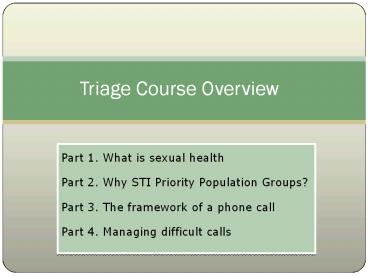Part 1: What is Sexual Health? - PowerPoint PPT Presentation
Title:
Part 1: What is Sexual Health?
Description:
Basic Triage Skills for Sexual Health Clinic Frontline Workers – PowerPoint PPT presentation
Number of Views:968
Title: Part 1: What is Sexual Health?
1
Triage Course Overview
- Part 1. What is sexual health
- Part 2. Why STI Priority Population Groups?
- Part 3. The framework of a phone call
- Part 4. Managing difficult calls
2
Part 1What is Sexual Health?
- If the average person knew as little about
eating as he does about sex, he would quickly
starve to death. - Dr. David Reuben
3
Part 1. What is sexual health?
- Learning objectives
- At the end of the session the learner will
- Develop an understanding of how we learn about
sex and why people might have sex - Identify the barriers to communicating about sex
- Define that sexual health is not merely the
absence of disease - Be aware of personal and professional sexual
health boundaries.
4
Learning about sex
- People learn about sex in many different ways,
such as through school education, friends and
family, magazines, books and other media and/or
through experience with sexual partners. As a
result people have varying levels of knowledge
about sex and STI risks.
5
Reasons people have sex
- People may have sex for different reasons
for example, pleasure, relaxation, pregnancy,
money or other forms of exchange, power, lust or
for commitment or love. - Sex is generally considered a personal and a
private matter and is usually not communicated
openly or explicitly.
6
- Sex is also confined by norms, which are
considered acceptable or not acceptable and
interpretations of this can vary between
individuals and groups.
7
- Stigma is social disapproval against behaviours
which vary from what is considered normal - Erving Goffman(1963) defined stigma as the
process by which normal identity is spoiled by
the reactions of others. - A person may be reluctant to admit to certain
sexual behaviours because of the stigma
associated with them. - A recent American national study (2010) reported
a wide range of sexual behaviours which varied
from the norm.
Ref Goffman E, (1963) Stigma Notes on the
Management of Spoiled Identity, Prentice-Hall,
1963. http//en.wikipedia.org/wiki/Stigma
8
- For these reasons people may not be able to
communicate effectively about sex and fear being
misunderstood or judged.
9
- Consequently people may not receive the right
information, support and help. It is important
to be aware of these barriers to communicating
when triaging.
10
Part 1. What is Sexual Health?
- 5 myths that stigmatise STIs
- Only people who have multiple partners get an STI
- Married people dont get STIs
- You can get STIs from toilet seats
- You cant get an STI through oral sex
- People usually know if they are infected
11
More Myths about STIs
- 5 more myths that stigmatise STIs
- Sex workers have lots of STIs
- Only gay men have HIV.
- People who have an STI are dirty.
- You cant get an STI if you only have one
partner. - You shouldnt have sex if you have an STI.
12
Definition of Sexual Health
Sexual Health is the integration of the
physical, emotional, intellectual and social
aspects of sexual being, in ways that are
positively enriching and that enhance
personality, communication and love (World
Health Organisation)
13
Fundamental to this concept is the right to
sexual information and the right to pleasure.
According to Mace and others, sexual health
includes three basic elements.
14
- A capacity to enjoy and control sexual and
reproductive behaviours in accordance with a
social and personal ethic - Freedom from fear, shame, guilt, false beliefs
and other psychological factors inhibiting sexual
response and impairing sexual relationships - Freedom from organic disorders, diseases and
deficiencies that interfere with sexual and
reproductive function. (WHO 1975)
15
- It is important to highlight there that sex is a
health issue and not a moral issue - Testing and treatment for sexually transmissible
infections, only cover one aspect of sexual
health.
16
Personal and Professional Boundaries
17
Personal and Professional Boundaries
- A common misconception is that when a person
talks about sex, it means they may be personally
interested. At work when you first start talking
about sex (particularly with strangers) it is
not unusual to feel a little anxious and unsure. - In sexual health, it is not voyeuristic to ask
certain questions as long as there is a clear
professional reason for asking them. There is a
clear distinction between personal and
professional boundaries. - For your professional development, it is helpful
to be aware of your personal boundaries and how
that may impact on your professional life.
18
Reflective Exercise
- Exercise 1
- Reflect on your knowledge and understanding of
sex - How did you learn about sex?
- Who can you talk to about sex and who wouldnt
you? - What makes it difficult to talk about sex
- Where would you go to for information and help?
19
Additional resources on personal boundaries
http//www.ehow.com/how_4833986_understand-maintai
n-healthy-personal-boundaries.html
http//www.suite101.com/content/protecting-persona
l-boundaries-a34799
http//www.dialog.unimelb.edu.au/lesbian/pdf/sex2
0in20australia20summary204.03.pdf
http//www.lifetoolsforwomen.com/p/personal-bounda
ries.htm































